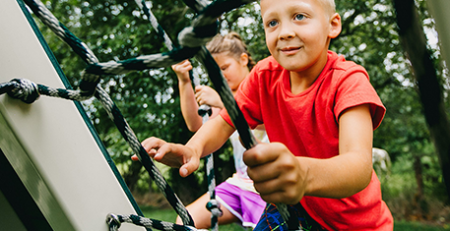
Sun Safety for Kids: Protecting Your Kids In the Brutal Summer Heat
Spending time outdoors and soaking up Vitamin D has plenty of health benefits. But not practicing proper sun safety for kids can lead to some unwanted problems. Heat exhaustion, sunburn, and dehydration — these are all things that can occur from too much time in the sun.
The good news is there are plenty of ways to achieve sun-safe backyard play. We’ll be breaking down some of our sun-safety tips for kids so you can teach your children how to stay protected in the brutal summer heat.
Types of Heat-Related Illnesses & Symptoms
Everyone’s had a time when they spent too much time in the sun. As adults, it’s much easier to understand when you’re starting to feel dehydrated or getting a sunburn. But as kids who might have never experienced a heat-related illness, they might not recognize the signs.
Before we break down sun safety for kids, we’re going to cover the common illnesses that stem from too much time in the heat and what symptoms to be on the lookout for.
Sunburn
Perhaps the most obvious, and most common, heat-related illness is sunburn. Too much time in the sun can overexpose our skin to the sun’s UV rays, which can increase the chances of skin cancer in the future. After as little as 15 minutes, our skin can start to burn.
The most common signs of sunburn include:
- Inflamed skin
- Skin that feels hot to the touch
- Pain, tenderness, or itching
For more severe cases of sunburn, kids might experience symptoms like:
- Swelling
- Blistering
- Fever, nausea, chills, and/or fatigue
- Eye-pain
To help ease the discomfort of common sunburns, your children should take cool baths or showers. To soothe the skin further, apply some moisturizer with aloe vera or soy to avoid dryness. They should also drink plenty of fluids to avoid dehydration.
Severe cases of sunburn may require medical attention if symptoms worsen or fail to improve. If fever, vomiting, dizziness, fainting, or infection occurs, you should reach out to your primary care doctor.

Dehydration
Dehydration is another common heat-related illness. It occurs when the fluids they sweat out while playing aren’t replaced with more fluids.
Aside from thirst, some of the common symptoms of dehydration include:
- Headache
- Light-headedness
- Fatigue
- Inability to play as hard
- Irritability
If you suspect your child is suffering from dehydration, start the rehydration process immediately. They should take a rest in a shaded area to cool off and start drinking some fluids like water or sports drinks that are high in electrolytes.
Heat Cramps
Exercising outside or in other hot environments can lead to involuntary muscle spasms, also known as heat cramps. As the child sweats, the body’s salt levels decrease. When the muscles don’t have enough salt, cramping occurs.
Typically, they occur in the calves, abdominals, or arms. The symptoms of heat cramps include:
- Sharp pain, not caused by a muscle strain
- Muscle contractions during and after exercise
If your child starts experiencing heat cramps, they should stop playing and start to replenish their bodies with electrolytes. They could also try some light stretching or massaging of the area to relieve some of the tension.
Heat Exhaustion
When children continue to stay active in the heat after already suffering from dehydration, heat exhaustion can occur. It’s most common in athletes who are training outside in the summer heat, but it can also occur in children who don’t tend to their dehydration.
Some symptoms might include:
- Dizziness or headache
- Fainting
- Pale skin
- Excessive sweating
- Nausea, vomiting, or diarrhea
- Stomach or muscle cramps (heat cramps)
Similar to if your child is experiencing dehydration, children suffering from heat exhaustion should be moved to an air-conditioned or cool, shaded area. If they’re able to, remove any excess layers of clothing and try to cool them down with water or a fan.
If they aren’t nauseous, they should also begin the rehydration process with water or sports drinks.
Heat Stroke
The most serious heat-related illness is a heat stroke. These occur when the body reaches an internal temperature of up to 106°F (or higher), and the body can’t manage the rapid increase in temperature.
If not treated with immediate emergency care, this heat-related illness can cause permanent damage or even death. Some symptoms of a heat stroke include:
- Slurred speech or confusion
- Excessive sweating
- Increase in body temperature
- Weakness or fatigue
- Loss of consciousness
- Seizures
If you suspect your child is having a heat stroke, call 911 immediately. As you wait for emergency care to arrive, move your child to a cool, shaded area and remove their top layers of clothing. If possible, cool them down with cold water using an ice bath or by placing cold wet clothes on their skin.

5 Tips For Staying Safe in the Sun
Heat-related illnesses in children can be scary, but the important thing to remember is that they can be avoided. Using these 8 sun safety tips for kids, you can teach your children how to protect themselves from the heat.
1. Stay Hydrated
This is sun safety 101. Dehydration is typically the root of the problem when it comes to heat-related illnesses. That’s why keeping your children hydrated when playing outside is so crucial.
Make sure that they are drinking plenty of fluids (water, sports drinks, Pedialyte®) and avoid caffeinated drinks like soda or tea. Offer it to them even if they’re not thirsty. Their body might need it even if they aren’t explicitly expressing it.

2. Apply & Reapply Sunscreen
Sunscreen is the number one way to protect our skin from UV rays. Anytime your children are playing outside, you should be applying a generous amount of sunscreen. For the best results, apply it 30 minutes before going outside, giving it time to absorb into the skin.
As a general rule, you should be reapplying sunscreen every 2 hours — sooner if they’re sweating it off or playing in water. And remember, your children can still get sunburned even on a cloudy day. The best way to protect your children is to apply sunscreen every time they’re going to be exposed to the sun.
3. Take Breaks in Shaded Spots
Scope out the scene to find shaded spots to rest. If your kids are playing at your neighborhood park, find some shade under a tree or public pavilion where they can cool down and rehydrate with some water.
If you have a playset of your own or are looking to purchase one, try to arrange it in a spot in your backyard where there’s some natural shade. Doing so can help reduce their exposure to direct sunlight, limiting the chance of sunburn or other heat-related illnesses.

If putting your playset in a shaded spot is not an option, Swing Kingdom has a large selection of roofs and canopies that you can purchase to create your own coverage from the sun.
Swing Kingdom playsets and accessories are built to stand up to harsh sunlight, so not only will your children have a safe, cool place to rest, but you won’t have to worry about fading or weathering.
4. Wear the Right Clothes
As silly as it sounds, wearing the right clothes can keep your children protected from the heat. The American Red Cross suggests wearing loose-fitting, lightweight clothes (cotton is best since it’s so breathable). If you can, avoid dressing them in dark colors which will absorb the sun’s rays.
If possible, your children should wear a hat and sunglasses to protect their faces and eyes from UV rays.
5. Know the Signs
Teaching proper sun safety for kids is so important. The best way to keep them protected is to keep them informed. Educate them on the warning signs and check in every so often to make sure they’re still feeling okay.
Children aren’t always as in tune with their bodies as adults, so it’s important that caregivers, too, are looking out for the signs. Take note of any changes in behavior, excessive sweating, or redness and intervene as necessary.









